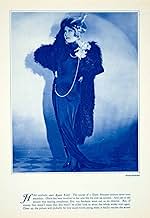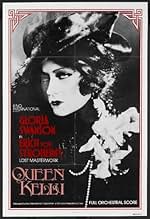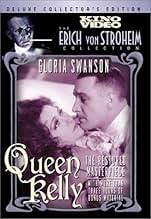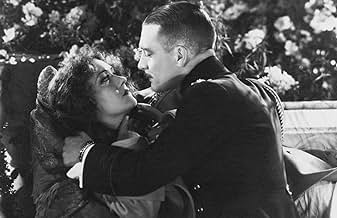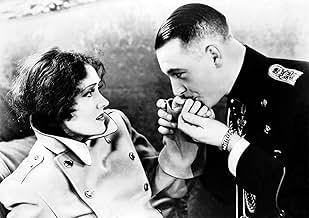CALIFICACIÓN DE IMDb
7.1/10
3.4 k
TU CALIFICACIÓN
Agrega una trama en tu idiomaA convent girl is abducted and seduced by a prince before being sent off to a brothel in East Africa.A convent girl is abducted and seduced by a prince before being sent off to a brothel in East Africa.A convent girl is abducted and seduced by a prince before being sent off to a brothel in East Africa.
- Dirección
- Guionistas
- Elenco
- Premios
- 1 premio ganado en total
Sylvia Ashton
- Kelly's Aunt
- (sin créditos)
Wilson Benge
- Prince Wolfram's Valet
- (sin créditos)
Sidney Bracey
- Prince Wolfram's Lackey
- (sin créditos)
Rae Daggett
- Coughdrops
- (sin créditos)
Robert Frazier
- Catholic Priest
- (sin créditos)
Florence Gibson
- Kelly's Aunt
- (sin créditos)
Madge Hunt
- Mother Superior
- (sin créditos)
Tully Marshall
- Jan Vryheid
- (sin créditos)
Ann Morgan
- Maid Escorting Kelly to Altar
- (sin créditos)
Madame Sul-Te-Wan
- Kali Sana - Aunt's Cook
- (sin créditos)
Lucille Van Lent
- Prince Wolfram's Maid
- (sin créditos)
Wilhelm von Brincken
- Prince Wolfram's Adjutant
- (sin créditos)
Gordon Westcott
- Lackey
- (sin créditos)
- Dirección
- Guionistas
- Todo el elenco y el equipo
- Producción, taquilla y más en IMDbPro
Opiniones destacadas
In an ancient European kingdom, sultry Seena Owen (as Queen Regina V) lounges, awaiting her nuptials with dashing Walter Byron (as Prince Wolfram). Nearby, convent girl Gloria Swanson (as Patricia Kelly) encourages the Lord's wrath by sleeping with her photographs of the handsome Mr. Byron. While he is out riding one day, Ms. Swanson gets a chance to meet the idolized Prince, and embarrassingly loses her knickers! For Swanson and Byron, it's love at first sight. But, how can a simple convent girl get the Queen's stud?
Director Erich von Stroheim and actress Gloria Swanson, with their skills in full tilt excess, are a joy to behold. Yet, "Queen Kelly" emerges as a fairly strong film, despite its self-indulgence. Once considered a hopelessly unfinished work; the film has been restored, with great integrity, through intertitles, stills, and imagination. There is no doubt Swanson would have played the final reels expertly; but, there is no way to tell if Stroheim and Swanson would have re-shot some of her opening footage. Few convent girls looked as gorgeous as Gloria Swanson, with her amplified eyelashes. Though she isn't the first (or last) Hollywood convent inhabitant to look so ravishing, it would have been wise to tone down the look, until later in the film.
Flaws notwithstanding, "Queen Kelly" is full of great stuff. Tobacco-stained Tully Marshall (as Jan Vryheid) and whip-wielding Ms. Owen are delightfully outrageous. Byron, pocketing her knickers, is a thoroughly charming partner for Swanson. Stroheim, and photographers Gordon Pollock and Paul Ivano, are outstanding; a simple scene of Swanson praying, with candles dripping around her, is beautiful.
Ah, they had faces then
Director Erich von Stroheim and actress Gloria Swanson, with their skills in full tilt excess, are a joy to behold. Yet, "Queen Kelly" emerges as a fairly strong film, despite its self-indulgence. Once considered a hopelessly unfinished work; the film has been restored, with great integrity, through intertitles, stills, and imagination. There is no doubt Swanson would have played the final reels expertly; but, there is no way to tell if Stroheim and Swanson would have re-shot some of her opening footage. Few convent girls looked as gorgeous as Gloria Swanson, with her amplified eyelashes. Though she isn't the first (or last) Hollywood convent inhabitant to look so ravishing, it would have been wise to tone down the look, until later in the film.
Flaws notwithstanding, "Queen Kelly" is full of great stuff. Tobacco-stained Tully Marshall (as Jan Vryheid) and whip-wielding Ms. Owen are delightfully outrageous. Byron, pocketing her knickers, is a thoroughly charming partner for Swanson. Stroheim, and photographers Gordon Pollock and Paul Ivano, are outstanding; a simple scene of Swanson praying, with candles dripping around her, is beautiful.
Ah, they had faces then
Erich von Stroheim's infamous final stab at direction (unfinished, when the plug was pulled by producer and star Gloria Swanson) is a sophisticated piece of silent cinema, wrapped in a camp plot and looking fabulous.
Gloria Swanson plays Patricia Kelly, a convent girl who meets the Prince of her dreams ('wild' Wolfram, played by Walter Byron) while she is out with the nuns. After a risqué scene concerning the soldiers and her bloomers, Gloria prays to the Holy Virgin to let her see the Prince again, while the Prince feels trapped in his engagement to the mad Queen Regina (a scene-chewing Seena Owen).
The first half of the film concerns how 'Kelly' and Wolfram come to meet up again, this time in the Palace where the jealous Queen loses no time in whipping Kelly out of doors and roaring that the Prince is 'Mine, MINE, MINE!'. The second half (unfinished) concerns Kelly's fortunes thereafter, called by her dying aunt to Africa where she finds herself in a brothel and betrothed to loathsome cripple drunk Jan Vryheid (a repellent and compelling performance from Tully Marshall), and eventually (and improbably) turns the situation round to get her happy ending, 'Queen Kelly' again.
Gloria Swanson looks absolutely gorgeous in the shimmering black and white close-ups, and her acting as Kelly is impeccable throughout - no one made better use of the 'look of horror' or the 'dipping of eyelashes' or the 'flirty smile'. Walter Byron is a moustachioed hero in the mould of John Gilbert and is an amusing second lead.
With the gaps plugged by wordy slides (in some prints, Kelly becomes Kitty in these explanatory bits, but never mind ...) and still photographs, 'Queen Kelly' is a boisterous and worthy final feature for its director. Many have seen a small bit of this film as part of Norma Desmond's home projections in 'Sunset Boulevard', but try to see the full thing - hugely enjoyable, and if not as mushily romantic as 'The Wedding March', its satirical splendor more than makes up for it!
Gloria Swanson plays Patricia Kelly, a convent girl who meets the Prince of her dreams ('wild' Wolfram, played by Walter Byron) while she is out with the nuns. After a risqué scene concerning the soldiers and her bloomers, Gloria prays to the Holy Virgin to let her see the Prince again, while the Prince feels trapped in his engagement to the mad Queen Regina (a scene-chewing Seena Owen).
The first half of the film concerns how 'Kelly' and Wolfram come to meet up again, this time in the Palace where the jealous Queen loses no time in whipping Kelly out of doors and roaring that the Prince is 'Mine, MINE, MINE!'. The second half (unfinished) concerns Kelly's fortunes thereafter, called by her dying aunt to Africa where she finds herself in a brothel and betrothed to loathsome cripple drunk Jan Vryheid (a repellent and compelling performance from Tully Marshall), and eventually (and improbably) turns the situation round to get her happy ending, 'Queen Kelly' again.
Gloria Swanson looks absolutely gorgeous in the shimmering black and white close-ups, and her acting as Kelly is impeccable throughout - no one made better use of the 'look of horror' or the 'dipping of eyelashes' or the 'flirty smile'. Walter Byron is a moustachioed hero in the mould of John Gilbert and is an amusing second lead.
With the gaps plugged by wordy slides (in some prints, Kelly becomes Kitty in these explanatory bits, but never mind ...) and still photographs, 'Queen Kelly' is a boisterous and worthy final feature for its director. Many have seen a small bit of this film as part of Norma Desmond's home projections in 'Sunset Boulevard', but try to see the full thing - hugely enjoyable, and if not as mushily romantic as 'The Wedding March', its satirical splendor more than makes up for it!
I am going to address the Kino DVD of Queen Kelly because that is how I saw the film (which is probably true of most of the film's North American viewers). Queen Kelly is never going to resemble anything close to what its director Erich von Stroheim imagined. Therefore, any version is a compromise. There are two options as releases go. An abbreviated version of what was filmed of the script was released with a hasty ending shot at the request of star Gloria Swanson. This version is called the Swanson cut. The second version is a restoration that includes all of the extant footage that was filmed (some materials having been lost). To fill in gaps, this release uses still photos and a scrawl at the end to inform viewers what was supposed to have happened had the production continued. Kino decided to release the film on DVD using the restoration while having the Swanson ending as an extra. I feel that this was a mistake, and Kino should have either released both versions of the film on the DVD (preferrably) or released the Swanson cut and had the found von Stroheim footage as an extra on the DVD.
The Swanson cut is a good movie, with a weak ending. However, it does a work as a movie, if a somewhat stunted one. There is a beginning (lovers meet), a middle (lovers spend an enchanted night together), and a quick ending. Along the way, the film conjures some wonderful scenes: Queen Regina with her cat descending upon Prince Wolfram and his dog, Kelly meeting the Prince and losing a piece of clothing, Kelly in the church sanctuary bathed in candlelight, and the climatic meeting between Kelly and the Queen.
By contrast, the restoration is problematic because it fails to go anywhere. There is a beginning, the start of a middle, and then a bunch of scenes, great masterful scenes, but scenes that do not pay off. Then the film ends with an epilogue explaining what the viewer might have seen had the film finished shooting and had then been edited and released the way von Stroheim intended (not a guarantee considering what happened with Greed which was all filmed).
I can appreciate Kino's dilemma. The found, unused scenes from the film feature some of the most astounding visuals and drama of any American silent film. The brothel setting oozes ornamental decadence. Film fans owe a lot to whomever preserved these scenes. Yet, I don't think the restoration works as a self-contained film. The found footage plays like a fascinating twenty minute trailer for a grand epic that no one will ever get to see. By taking out Swanson's ending and putting in this footage, the restorers end with an unfinished film and a frustrating viewing experience.
I happened to be reading Andrew Sarris's The Primal Screen during the same period I watched Queen Kelly. A quote stood out from that book which fit director von Stroheim.
"I think it is a mistake for critics to scold artists or event to bemoan their bad luck . . . . It is better to accept and appreciate the supposed 'disappointments' of our time - Welles, Mailer, Salinger - for what they have done rather than for what they might have done if we had been able to crack the whip over them. They have all done as much as they were humanly capable of doing, and so did Fitzgerald, Hemingway, and Dos Passos before them, and thank God for The Great Gatsby, The Sun Also Rises and U.S.A. and never mind the rude avoidance of encores."
Yes, thank God for any version of Greed and Queen Kelly, even if I do believe that the restorations of both films are less satisfying for viewers than the original, theatrical cuts.
The Swanson cut is a good movie, with a weak ending. However, it does a work as a movie, if a somewhat stunted one. There is a beginning (lovers meet), a middle (lovers spend an enchanted night together), and a quick ending. Along the way, the film conjures some wonderful scenes: Queen Regina with her cat descending upon Prince Wolfram and his dog, Kelly meeting the Prince and losing a piece of clothing, Kelly in the church sanctuary bathed in candlelight, and the climatic meeting between Kelly and the Queen.
By contrast, the restoration is problematic because it fails to go anywhere. There is a beginning, the start of a middle, and then a bunch of scenes, great masterful scenes, but scenes that do not pay off. Then the film ends with an epilogue explaining what the viewer might have seen had the film finished shooting and had then been edited and released the way von Stroheim intended (not a guarantee considering what happened with Greed which was all filmed).
I can appreciate Kino's dilemma. The found, unused scenes from the film feature some of the most astounding visuals and drama of any American silent film. The brothel setting oozes ornamental decadence. Film fans owe a lot to whomever preserved these scenes. Yet, I don't think the restoration works as a self-contained film. The found footage plays like a fascinating twenty minute trailer for a grand epic that no one will ever get to see. By taking out Swanson's ending and putting in this footage, the restorers end with an unfinished film and a frustrating viewing experience.
I happened to be reading Andrew Sarris's The Primal Screen during the same period I watched Queen Kelly. A quote stood out from that book which fit director von Stroheim.
"I think it is a mistake for critics to scold artists or event to bemoan their bad luck . . . . It is better to accept and appreciate the supposed 'disappointments' of our time - Welles, Mailer, Salinger - for what they have done rather than for what they might have done if we had been able to crack the whip over them. They have all done as much as they were humanly capable of doing, and so did Fitzgerald, Hemingway, and Dos Passos before them, and thank God for The Great Gatsby, The Sun Also Rises and U.S.A. and never mind the rude avoidance of encores."
Yes, thank God for any version of Greed and Queen Kelly, even if I do believe that the restorations of both films are less satisfying for viewers than the original, theatrical cuts.
Eric Von Stroheim (1885-1957) was among the silent era's most visionary, artistically ambitious directors; Gloria Swanson (1897-1983) was among the screen's first "divas" and one of the silent era's greatest stars. With Swanson's lover Joe Kennedy (father of John, Robert and Ted) acting as money man, Von Stroheim and Swanson teamed to create a film that both believed would be crowing achievement of their careers: QUEEN KELLY.
Less than a third of the script was filmed when Swanson called Kennedy and demanded that Von Stroheim be fired. He was, and in his absence Swanson filmed several scenes intended to round out the story line and make the film fit for release. In doing so she reckoned with Von Stroheim, who had cannily held copyright and who flatly refused to permit distribution--and as the battle wore on sound began to roar, making the film less commercially viable with every passing day. Swanson was eventually able to release QUEEN KELLY in Europe, but it generated little interest and was soon withdrawn. It would not be seen in America until after Von Stroheim's death. It would be Von Stroheim's last major work as a director and it would effectively end Swanson's film career for a decade or more.
In the interval the reputation of QUEEN KELLY began to grow. It was, many declared, a lost masterpiece much like Von Stroheim's legendary GREED. And when it at last became widely available it leaped onto every critic and buff's short list of "important" silent movies. But time has a way of smoothing out peaks and valleys. Seen today, QUEEN KELLY is interesting--but only for what it might have been, not for what it actually is.
The story is distinctly odd. Prince Wolfram (Walter Byron) is betrothed to Queen Regina (Seena Owen), a vicious, half-mad, and intensely despot he despises. While riding in the country he comes upon a group of orphans that includes Kitty Kelly (Gloria Swanson), who makes an impression on him by loosing her bloomers and then angrily throwing them in his face when he laughs at her. Determined to see her again, the Prince stages a fire in the convent and under cover of smoke kidnaps Kitty and takes her to the palace, where she soon surrenders to his charms. But there is hell to pay when Queen Regina discovers the girl, and before you know it Prince Wolfram is in the dungeon and Kitty has, of all things, inherited a brothel in Africa. Will they find each other again? It is basically at this point that the film footage ends. The Kino release attempts to finish out the story with a handful of stills and title cards, and true enough we do learn the outcome of the story--but it is a very academic proposition, to say the very least, and although it seems to have a certain promise it is very hard to say what Stroheim might have done with the rest of the story. Hopefully more than he was able to do with the first third! For while the existing footage is not bad, it hardly compares with either Stroheim or Swanson at their finest.
Indeed, Swanson seems extremely miscast in the title role. It is utterly impossible to accept her as an innocent orphan raised in a convent. Much more interesting is Seena Owen as the evil Queen Regina, who is sullen, dangerous, and utterly fascinating; in the film's most memorable scene, in which Kitty is chased through the palace by the whip-wielding Queen, it is Owen who dominates the scene, not Swanson. As for Von Stroheim, he is clearly building a series of visual motifs that reference sex, most notably in his use of candles, fires, and smoke--but with the film suddenly unfinished it is very difficult to know to what end he intended it.
This is really a film for silent film connoisseurs, and even they may find it frustrating to the point of annoyance. The Kino print is very good, but there is no getting around the fact that the film itself ends at the very point at which our interest in both plot and characters begins to build. Recommended, but as a curiosity only. Trivia: some twenty years later Swanson and Von Stroheim co-starred in the legendary SUNSET BLVD--and the film that silent star Norma Desmond watches is none other QUEEN KELLY.
Gary F. Taylor (aka GFT, Amazon Reviewer)
Less than a third of the script was filmed when Swanson called Kennedy and demanded that Von Stroheim be fired. He was, and in his absence Swanson filmed several scenes intended to round out the story line and make the film fit for release. In doing so she reckoned with Von Stroheim, who had cannily held copyright and who flatly refused to permit distribution--and as the battle wore on sound began to roar, making the film less commercially viable with every passing day. Swanson was eventually able to release QUEEN KELLY in Europe, but it generated little interest and was soon withdrawn. It would not be seen in America until after Von Stroheim's death. It would be Von Stroheim's last major work as a director and it would effectively end Swanson's film career for a decade or more.
In the interval the reputation of QUEEN KELLY began to grow. It was, many declared, a lost masterpiece much like Von Stroheim's legendary GREED. And when it at last became widely available it leaped onto every critic and buff's short list of "important" silent movies. But time has a way of smoothing out peaks and valleys. Seen today, QUEEN KELLY is interesting--but only for what it might have been, not for what it actually is.
The story is distinctly odd. Prince Wolfram (Walter Byron) is betrothed to Queen Regina (Seena Owen), a vicious, half-mad, and intensely despot he despises. While riding in the country he comes upon a group of orphans that includes Kitty Kelly (Gloria Swanson), who makes an impression on him by loosing her bloomers and then angrily throwing them in his face when he laughs at her. Determined to see her again, the Prince stages a fire in the convent and under cover of smoke kidnaps Kitty and takes her to the palace, where she soon surrenders to his charms. But there is hell to pay when Queen Regina discovers the girl, and before you know it Prince Wolfram is in the dungeon and Kitty has, of all things, inherited a brothel in Africa. Will they find each other again? It is basically at this point that the film footage ends. The Kino release attempts to finish out the story with a handful of stills and title cards, and true enough we do learn the outcome of the story--but it is a very academic proposition, to say the very least, and although it seems to have a certain promise it is very hard to say what Stroheim might have done with the rest of the story. Hopefully more than he was able to do with the first third! For while the existing footage is not bad, it hardly compares with either Stroheim or Swanson at their finest.
Indeed, Swanson seems extremely miscast in the title role. It is utterly impossible to accept her as an innocent orphan raised in a convent. Much more interesting is Seena Owen as the evil Queen Regina, who is sullen, dangerous, and utterly fascinating; in the film's most memorable scene, in which Kitty is chased through the palace by the whip-wielding Queen, it is Owen who dominates the scene, not Swanson. As for Von Stroheim, he is clearly building a series of visual motifs that reference sex, most notably in his use of candles, fires, and smoke--but with the film suddenly unfinished it is very difficult to know to what end he intended it.
This is really a film for silent film connoisseurs, and even they may find it frustrating to the point of annoyance. The Kino print is very good, but there is no getting around the fact that the film itself ends at the very point at which our interest in both plot and characters begins to build. Recommended, but as a curiosity only. Trivia: some twenty years later Swanson and Von Stroheim co-starred in the legendary SUNSET BLVD--and the film that silent star Norma Desmond watches is none other QUEEN KELLY.
Gary F. Taylor (aka GFT, Amazon Reviewer)
I'd imagine that most people who would come to this page to read a review of Erich Von Stroheim's unfinished epic Queen Kelly already know something about it, but nonetheless it seems a little historical context is necessary before attempting to critique the fragment that remains. This was a deeply troubled project, memorably described by leading lady Gloria Swanson as a child that refused to be born. Set in a fictitious 'Middle European' kingdom, the first portion of Von Stroheim's screenplay tells a fairy tale-like story of an innocent convent girl, Patricia Kelly, who becomes involved with a wastrel Prince-- who, unbeknownst to her, is already betrothed to the Queen. At first the Prince wants only to toy with Kelly, but in the course of their one evening together he sincerely falls in love with her. Unfortunately, the mad Queen Regina learns of the affair and literally flogs Kelly out of the palace. Kelly attempts suicide, but is rescued and abruptly sent to German East Africa, where her dying aunt runs a brothel. She is forced to marry a syphilitic plantation owner and eventually winds up successfully running the brothel herself, under the ironic moniker "Queen Kelly."
As originally scripted this film might have run as long as five hours, so the portion available today represents barely one-third of the intended opus. The project marked the sole collaboration between writer/director Von Stroheim, star/producer Swanson, and co-producer Joseph P. Kennedy, patriarch of the political dynasty (who was also Swanson's lover at the time). Plans for this silent epic were launched at the end of 1927, but by the time shooting began in fall of 1928 the talkie revolution was sweeping Hollywood, and this would prove to be perhaps the biggest single factor that doomed the project to limbo. Three months into the filming Von Stroheim was fired, and for the next few years Swanson attempted to finish the movie in various ways, finally releasing a truncated version in Europe in 1932. In the 1960s about twenty minutes' worth of footage from the sequence set in Africa was discovered, and this material was reunited with the earlier portion in a restored version completed in 1985.
Given this history it seems almost unfair to critique what remains of Queen Kelly at all, but the restoration presents a rough idea of what the movie might have amounted to in its longer form. This is a fascinating fragment with both positive and negative aspects.
On the positive side, the film is beautiful to look at; Paul Ivano's gleaming cinematography ranks with the best work of the era. Practically every shot boasts features of striking interest, and the production design teems with the sort of character-revealing detail for which Von Stroheim was known. Befitting the unreal atmosphere, Seena Owen and Tully Marshall offer highly stylized character turns as Queen Regina and plantation owner Jan Vryheid. Owen's Mad Queen is unforgettable, lounging about the palace nude (while toting a strategically positioned white cat!), surrounded by erotic art and brandishing a riding crop. Marshall's scenes are limited to a few minutes in the recovered 'Africa' footage, but he etches a vivid portrait of creepy decadence.
On the debit side, however, is the central and insurmountable problem that Gloria Swanson was miscast in the title role: she simply isn't credible as the innocent convent girl the story demands. Kelly is supposed to be a sheltered girl who has never tasted champagne. Swanson was 31 years old when this film was made and, frankly, looked older. Even in films she made in her early 20s she comes off as a tough cookie who could handle anything, but here, alongside the actual girls who are supposed to be her contemporaries, Gloria looks like she should be playing the Mother Superior. Von Stroheim's leading lady from The Wedding March, 21 year-old Fay Wray, would have been perfect as Kelly, but once producer Swanson cast herself in the role the project was inherently flawed.
Another problem is that most of this material was edited together only after Von Stroheim had been fired and the production shut down, when Swanson was attempting to assemble a marketable feature-length movie out of the opening 'Middle Europe' section. Originally these scenes had been intended to serve as little more than a prologue to the Africa story, but since it was the only portion completed the editors were forced to extend what they had to pad the running time. There is much lingering over details and too many prolonged reaction shots, especially in the scenes between Kelly and the Prince. It's said that when Erich Von Stroheim saw this version of the film in later years he complained that the pace was far too slow, and so it appears today: sumptuously photographed but draggy, despite the occasional high points.
In sum, while I would call this film a must for silent movie buffs, I don't believe the average viewer would find much to enjoy in Queen Kelly. This is one of those legendary disasters with a "backstory" rather more interesting than what we see on screen. In that light I can especially recommend watching the recent DVD release with film scholar Richard Koszarski's commentary accompanying the visuals, to help make sense of it all.
As originally scripted this film might have run as long as five hours, so the portion available today represents barely one-third of the intended opus. The project marked the sole collaboration between writer/director Von Stroheim, star/producer Swanson, and co-producer Joseph P. Kennedy, patriarch of the political dynasty (who was also Swanson's lover at the time). Plans for this silent epic were launched at the end of 1927, but by the time shooting began in fall of 1928 the talkie revolution was sweeping Hollywood, and this would prove to be perhaps the biggest single factor that doomed the project to limbo. Three months into the filming Von Stroheim was fired, and for the next few years Swanson attempted to finish the movie in various ways, finally releasing a truncated version in Europe in 1932. In the 1960s about twenty minutes' worth of footage from the sequence set in Africa was discovered, and this material was reunited with the earlier portion in a restored version completed in 1985.
Given this history it seems almost unfair to critique what remains of Queen Kelly at all, but the restoration presents a rough idea of what the movie might have amounted to in its longer form. This is a fascinating fragment with both positive and negative aspects.
On the positive side, the film is beautiful to look at; Paul Ivano's gleaming cinematography ranks with the best work of the era. Practically every shot boasts features of striking interest, and the production design teems with the sort of character-revealing detail for which Von Stroheim was known. Befitting the unreal atmosphere, Seena Owen and Tully Marshall offer highly stylized character turns as Queen Regina and plantation owner Jan Vryheid. Owen's Mad Queen is unforgettable, lounging about the palace nude (while toting a strategically positioned white cat!), surrounded by erotic art and brandishing a riding crop. Marshall's scenes are limited to a few minutes in the recovered 'Africa' footage, but he etches a vivid portrait of creepy decadence.
On the debit side, however, is the central and insurmountable problem that Gloria Swanson was miscast in the title role: she simply isn't credible as the innocent convent girl the story demands. Kelly is supposed to be a sheltered girl who has never tasted champagne. Swanson was 31 years old when this film was made and, frankly, looked older. Even in films she made in her early 20s she comes off as a tough cookie who could handle anything, but here, alongside the actual girls who are supposed to be her contemporaries, Gloria looks like she should be playing the Mother Superior. Von Stroheim's leading lady from The Wedding March, 21 year-old Fay Wray, would have been perfect as Kelly, but once producer Swanson cast herself in the role the project was inherently flawed.
Another problem is that most of this material was edited together only after Von Stroheim had been fired and the production shut down, when Swanson was attempting to assemble a marketable feature-length movie out of the opening 'Middle Europe' section. Originally these scenes had been intended to serve as little more than a prologue to the Africa story, but since it was the only portion completed the editors were forced to extend what they had to pad the running time. There is much lingering over details and too many prolonged reaction shots, especially in the scenes between Kelly and the Prince. It's said that when Erich Von Stroheim saw this version of the film in later years he complained that the pace was far too slow, and so it appears today: sumptuously photographed but draggy, despite the occasional high points.
In sum, while I would call this film a must for silent movie buffs, I don't believe the average viewer would find much to enjoy in Queen Kelly. This is one of those legendary disasters with a "backstory" rather more interesting than what we see on screen. In that light I can especially recommend watching the recent DVD release with film scholar Richard Koszarski's commentary accompanying the visuals, to help make sense of it all.
¿Sabías que…?
- TriviaA clip from the film appears in El ocaso de una vida (1950), where Norma Desmond (played by Gloria Swanson), a silent movie star who is planning a comeback, watches one of her former films. Erich von Stroheim plays Max Von Mayerling, Desmond's butler, who serves as projectionist for the film clip. It is later revealed that Max was the silent movie director who discovered Norma Desmond. Director Billy Wilder recalled that it was von Stroheim's idea to use the clip from Queen Kelly (1932) in El ocaso de una vida (1950), to add realism.
- ErroresThe positions of the two different groups, the troops and the convent girls, are constantly changing in relation to the shrine on Kambach road.
- Citas
[as Wolfram and Fritz are racing their horses down the street]
Girl 1: Come on, Wild Wolfram! I've bet my nightie on you!
Girl 2: Come on, Fritz! She hasn't GOT a nightie!
- Versiones alternativasDirector Erich von Stroheim never completed the film: the ending is made using stills and subtitles. The European version has a different storyline than the American one.
- ConexionesEdited from Queen Kelly: The Kino Restored International Ending (2011)
Selecciones populares
Inicia sesión para calificar y agrega a la lista de videos para obtener recomendaciones personalizadas
- How long is Queen Kelly?Con tecnología de Alexa
Detalles
Taquilla
- Presupuesto
- USD 800,000 (estimado)
- Tiempo de ejecución
- 1h 41min(101 min)
- Color
- Mezcla de sonido
- Relación de aspecto
- 1.33 : 1
Contribuir a esta página
Sugiere una edición o agrega el contenido que falta


